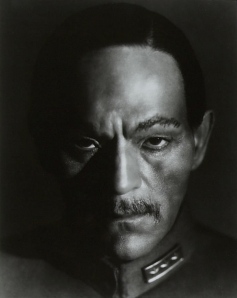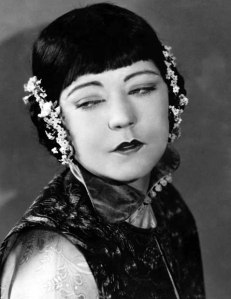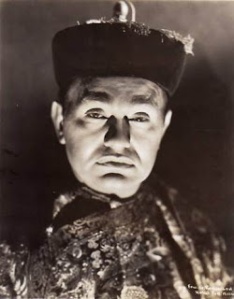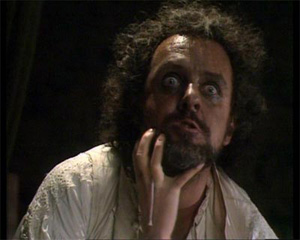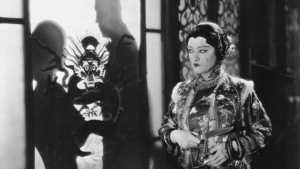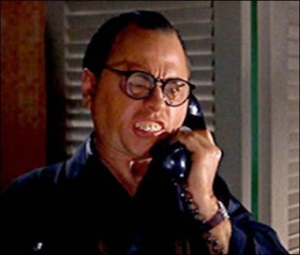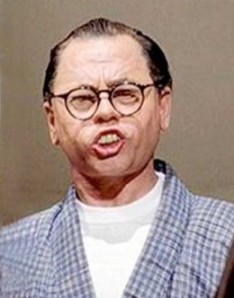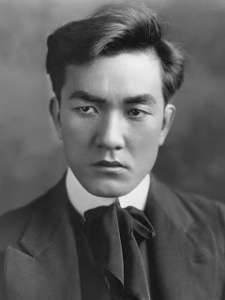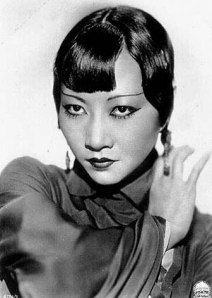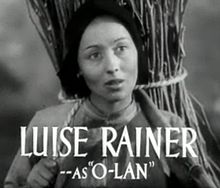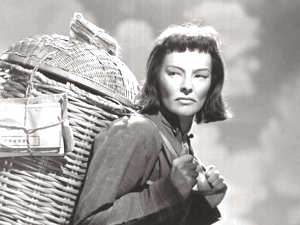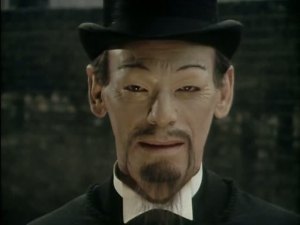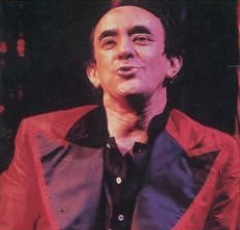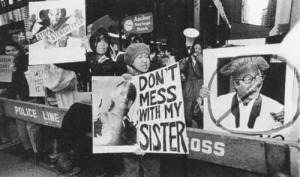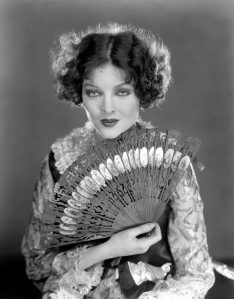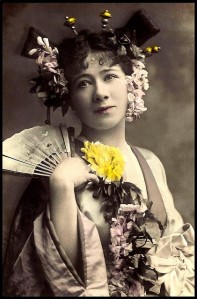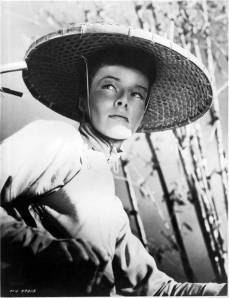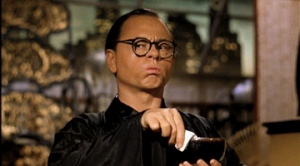In short, “yellowface” is when an actor who is not of East Asian descent portrays a character who is of East Asian descent. This has become associated with make-up and prosthetics though some of the earliest “yellowface” film performances didn’t use make-up at all leaving the “Orientalism” merely to costume and “mannerisms”. Indeed it is sometimes used as a justification in our supposedly more enlightened age, that if the actors aren’t actually taping their eyelids and colouring themselves then this does not constitute yellowface and is therefore acceptable.
Whatever one’s opinion of this rationalisation there is no doubting that yellowface has proved infinitely more enduring than “blackface” which is now deemed more or less taboo. It is worth bearing in mind though that the last blackface Othello in Britain was Michael Gambon as recently as 1991. In fact in 1979 the BBC pointedly refused to cast a black British actor as the Moor and instead cast Antony Hopkins after Equity had refused to allow the black American actor James Earl Jones to take the role. Leading black actor Rudolph Walker (now a BBC mainstay after a successful classical career) is on record saying how distressing this blanket rejection of the British black acting community was and in this incident we can see clearly all the hallmarks of modern racial appropriation manifested in the extreme reluctance to look outside the accepted “circle” when casting any kind of substantial role. That “circle” will of course consist only of very tokenistic (at best) minority ethnic presence unless some form of risk is taken to open up to the possibilities offered by actors from different backgrounds.
Theatre, film & TV is, contrary to many peoples’ preconceptions, a deeply conservative medium that time and again has to be dragged kicking and screaming into the modern world. The age-old justification of course is that there is no one available or good enough. It is arguable that who is and isn’t allowed on stages is a deeply political decision often made by people who, for whatever reason, are uneasy about allowing the floodgates to open. In Shakespeare’s day there were no women on stage. Was this because it was not in the female DNA to be able to perform at that time? One only has to look at old black & white films to see obviously posh actors portraying working-class characters, acting being at that time a genteel profession and not generally for the “riff-raff”. And then there was the whole struggle in the 70’s and 80’s for black actors to be seen on UK stages. One particular theatre director around the time even attempted to argue that Shakespeare was difficult for black actors as it was “not part of their culture”.
Yellowface (the last acceptable bastion of racial impersonation) originated in a time (late 19th-early 20th Century) when the combination of two opium wars and an outpouring of cheap labour had made East Asians very possibly the most despised minority group in the Western world. Paradoxically though “Oriental” clothing, décor and ornamentation were very much in fashion in good society, especially London. There was at one point in the 1920’s five plays running concurrently in the West End that featured Chinese characters (all played by Caucasian actors) though all five prompted complaints from Chinese students about the manner in which the Chinese were portrayed. Something of a running theme developed around this time with the Chinese government actually advising its overseas citizens not to appear as extras in films where the Chinese were shown in a derogatory light (which was practically all of the time in truth). This controversy has continued since with Mickey Rooney’s legendarily infamous turn in Breakfast At Tiffany’s still causing offence to this day. It’s difficult not to come to the conclusion that this appropriation of identity and culture (sometimes, as in Rooney’s case, for the purposes of “fun”), whilst not allowing any meaningful contribution from the people whose identity and culture is being appropriated, is in its very essence colonial.
Despite all this there were East Asian actors in the early days of Hollywood who made a significant impact with the Japanese silent screen star Sessue Hayakawa possibly the first, his brooding good looks and easy charisma earning a sizeable following. Indeed it’s been argued that much “yellowface” casting was down to the establishment’s unease at Sessue’s popularity. Anything but the stereotypical asexual and subservient “oriental” male that Western media seems so fixated on, Hayakawa very much enjoyed the glamorous lifestyle of the early movie stars, throwing lavish parties and wearing expensive clothes and it is said that many were uncomfortable with both this and his evident popularity. His career certainly suffered in 1930’s though he was later nominated for an Academy Award for his performance in The Bridge Over The River Kwai.
Hayakawa’s Daughter Of Fu Manchu co-star Anna May Wong was another to make a big impression. Glamorous and effortlessly iconoclastic May Wong was the first to break the anti-miscegenation taboo by playing opposite a white a romantic lead in 1922’s Toll Of The Sea. Despite this success, Anna cut a frustrated figure eventually abandoning Hollywood for Europe where she told Film Weekly she was “tired” of the roles she was given and that, “there seems little for me in Hollywood, because, rather than real Chinese, producers prefer Hungarians, Mexicans, American Indians for Chinese roles.” May Wong showed the courage of her convictions in 1935 when she was passed over for the lead role in one of the most famous yellowface films of all time, The Good Earth. The producers elected to cast the Swedish actress Luise Rainer, instead offering Anna the stereotypical “Oriental Dragonlady” role which she bravely declined. It’s a little-noted fact that May Wong was Bertolt Brecht’s first choice to play the title role in his The Good Person Of Setzuan, a play it’s often argued that Brecht didn’t write with Chinese actors in mind. It is however there for all to see that one of the 20th Century’s greatest and most enduring dramatists was clearly far more open to the possibility of East Asian actors performing the play than many of today’s leading theatrical lights have been. In a further bitter footnote, Anna was vilified at the time by the Nationalist Kuomintang government of China where there were demontrations against her for what was perceived as her “unflattering” portrayals of Chinese characters, proving (not for the last time) the enormous difficulty of being an East Asian artist with any kind of integrity in the West, as she was shot mercilessly by both sides .
The list of Hollywood actors to “yellow up” on screen is an impressive one including Lon Chaney, Edward G. Robinson, Loretta Young, Boris Karloff, Peter Lorre, Anthony Quinn, Warner Oland, Sydney Toler, Peter Ustinov, Shirley Maclaine, Katherine Hepburn, Rina Morena, Rex Harrion, John Wayne, Mickey Rooney, Marlon Brando, Alec Guiness, Tony Randall,, John Gielgud, Max Von Sydow, Linda Hunt, Jamie Lee Curtis, David Carradine, Joel Grey and many others. The Welsh-American Myrna Loy played Chinese/Eurasian dragon-ladies to such an extent (over a dozen films including Fu Manchu’s daughter in The Mask Of Fu Manchu) that she felt it was a stereotype she actually had to struggle to escape. A savage irony indeed. Meanwhile Korean-American actor Philip Ahn (who did manage to go on and forge a career in film and television) was turned down for a role in the film of Anything Goes as his English was deemed too proficient, so demeaning was Hollywood’s view of genuine East Asian performers.
What’s especially interesting is the level of defensiveness and indeed championing that still exists to this day around yellowface. As recently as 1985 Joel Grey was nominated for an Academy Award for his performance as Chiui in the now little-remembered Remo James. A search of the BBC’s Dr. Who website will reveal that John Bennet’s portrayal (in heavy make-up and accent) of Li H’sen Chang in 1977’s The Talons Of Weng-Chiang is considered by the nation’s favourite boradcaster “faultless” and “so convincing that it is difficult to believe that he is not actually Chinese”. They also describe Bennet’s character as “inscrutable”
Cameron Macintosh to this day defends and celebrates his casting of Jonathan Pryce in the original production of Miss Saigon, a decision that caused street protests when the play opened on Broadway (though nothing here sadly). With the Vietnam-set musical due to be revived in 2014 one wonders what approach the producers will take this time. They may defend the casting of Pryce but it’s interesting that there are very few pictures of him online where his (heavily prostheticised) face is visible and virtually none of his succesors, Nick Colder and Hilton Macrae. Pryce himself showed how remarkably out of touch much of the establishment acting profession is with diversity issues when he argued in a TV interview that he’d never considered the implication of his taking on the role of The Engineer as he was used to being at the RSC where “colour-blind” casting was the norm. This would be the Royal Shakespeare Company where Jonathan had previously given a very fine performance as Macbeth that contained a grand total of two black actors (one of whom understudied the other). One less than the number of East Asian actors playing roles described by critics as “minor” in the same company’s production of The Orphan Of Zhao in 2012. And we all know what happened there, don’t we?
It’s clear there are all sorts of issues with actors of East Asian descent appearing on UK stages and screens. Headlong Artistic Director Rupert Goold has even been muttering darkly on Twitter about “institutional prejudices” that needed to be overcome in order for the recent smash-hit Chimerica to be brought to the stage. David Henry Hwang’s Yellowface also enjoyed a successful run at London’s new Park Theatre recently but only after it was self-produced with no Arts Council support by actor Kevin Shen. The play was refused by several established theatres with the resources to present it. One can only wonder why. Hwang’s previous London produced play, M. Butterfly, in the late ‘80’s, ran for six months at the Shaftesbury Theatre. It’s next to impossible to imagine a black American writer with a similar pedigree to David’s with such a (relatively) inexpensive play with such incendiary, thought-provoking and funny subject matter being ignored in this way by the London mainstream theatre industry. Even without this kind of innate resistance there’s the “perennial foreigner” factor to overcome. The National Theatre Of Scotland in early 2013 defended their decision to have a small majority of Caucasian actors perform in their China plays season on the grounds they wanted to explore the cultural exchange between Chinese and Scottish performers and writers. Yet considering that the East Asian actors they did cast were indigenous home-grown ones are the two “cultures” really so far removed from each other in 2013?
In the end, though, perhaps it’s sheer economics that have been the biggest barrier to casting East Asian descended actors. In Lolita Chakrabarti’s Red Velvet (about the trail-blazing black actor Ira Aldridge) one character asks another how they will feel when the likes of Aldridge are “taking your jobs”. Asian-American dancer/actor Robert Ito wrote in an article, “With the relatively small percentage of actors that support themselves by acting, it was only logical that they should try to limit the available talent pool as much as possible. One way of doing this was by placing restrictions on minority actors, which, in the case of Asian actors, meant that they could usually only get roles as houseboys, cooks, laundrymen, and crazed war enemies, with the rare “white hero’s loyal sidekick” roles going to the big name actors. When the script called for a larger Asian role, it was almost inevitably given to a white actor.”
Soon we will be uploading reviews of actual yellowface films (the ones we could find online that is). But first we will examine Fu Manchu (a yellowface legend if ever there was one) on screen. Do join us and remember to book your tickets for The Fu Manchu Complex http://www.ovalhouse.com/whatson/detail/the-fu-manchu-complex Oct. 1st-19th. More details (including trailer) here http://www.thefumanchucomplex.com/
